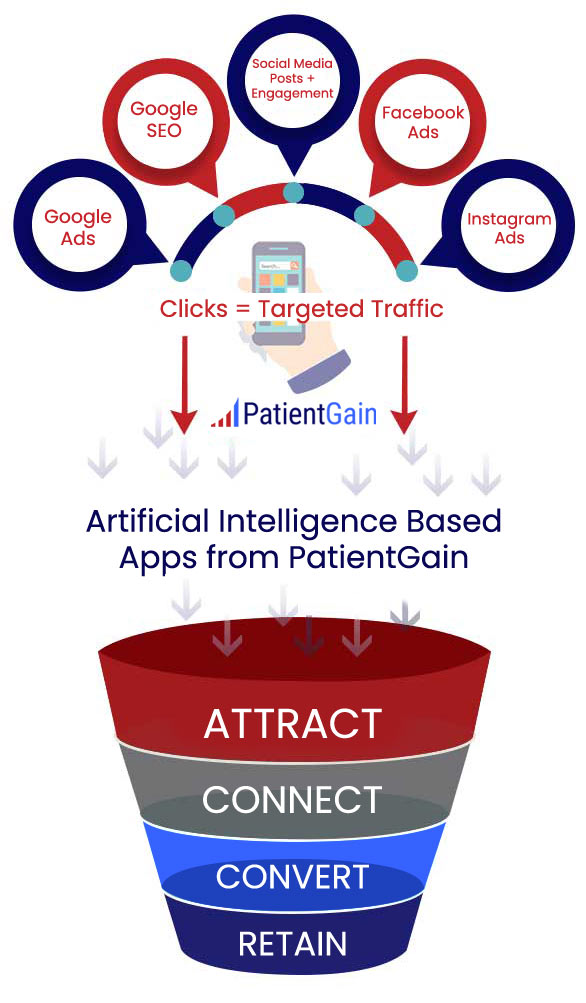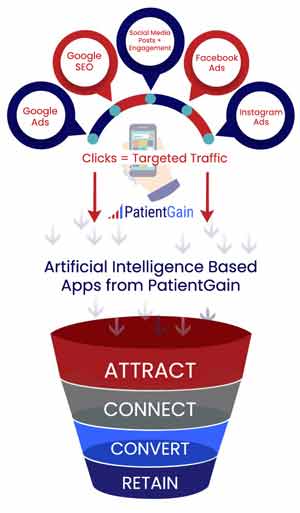How to Build a Social Following for Your Medical & MedSpa Practice
Many providers and practice managers believe that social media following can turn their medical practice into a thriving business. While this will generally increase patient engagement, and brand awareness, this does not automatically translate into high number of new patients.
Don’t get stuck on followers. Focus on quality leads.
Your brand might think about social media as building a community — because at one time it was possible to reach many of your followers. Now, social platform algorithms have limited how much brand content users see in the feed. Meaning, even if you had a million followers tomorrow, only a handful would be able to see your post.
Your social media marketing objectives need to shift. Instead of focusing on followers, medical practices should view social media as accomplishing two primary objectives.
The first and foremost objective medical practices should have for social should be educating and engaging with potential patients. Start by understanding the key questions patients want answered, which will generally take the form of content about conditions, treatments and FAQs. So posting about your services and benefits of your services is the key. You do not need to post about “SPECIALS” and “OFFERS” all the time. Patients are just like you. They do not want to be “sold”. Simply provide useful information.
Understand that social media companies exist to make money. They will never provide you access to millions of potential patients without any payment. So you must have an advertising budget for your social media strategy.
There are many ways to advertise on social media platforms.
- Boosting your posts – This is a simple task, however we see minimal impact on patient acquisition by boosting a post.
- Targeted advertising – This used to be fairly simple task, but not anymore. While setting up a Facebook and Instagram ads campaign, we counted over 67 settings for a medical marketing campaign. You also will need to create graphic design for the visual layout of the ad., Then you will need to think about “capturing the lead”. We do not recommend storing any lead information in any social media platform, this is due to HIPAA compliance. We recommend capturing leads into a HIPAA compliant funnel app. Learn more advertising on digital mediums.


Both boosting social media posts and placing ads have their merits in terms of expanding the reach of your content. Here’s an integrated breakdown to help you decide which approach is best for your needs:
Boosting Posts (costs money)
- Leverages Existing Content: Boosting involves amplifying the reach of an already created organic post to both your network of followers and beyond.
- Simpler and Faster: This method is quicker and easier than creating a new ad from scratch, ideal for those looking to enhance engagement swiftly.
- Lower Cost: Generally less expensive than running full-fledged ad campaigns, the cost depends on your budget and the targeting options chosen.
- Limited Targeting: While you can target demographics and interests, the options are less granular compared to what’s available with paid ads.
- Lower Visibility: Boosted posts may not achieve the same level of reach or prominence as paid ads, especially in competitive content environments.
Placing Ads (more effective than boosting, but it is more complex and more expensive)
- Highly Customizable: Allows for the creation of content specifically designed for your advertising goals, with extensive control over visuals, messaging, and landing pages.
- Advanced Targeting: Offers a range of targeting options, including demographics, interests, behaviors, and lookalike audiences based on existing customer data.
- Greater Reach: Ads can extend your reach far beyond current followers, targeting potential new patients or specific demographics you aim to attract.
- Measurable Results: Provides detailed analytics to track ad performance, enabling ongoing optimization of your campaigns for better outcomes.
- Higher Cost: Typically involves a higher upfront investment, with costs varying based on platform, targeting options, and campaign duration.
Choosing the Right Approach
- Boosting is Ideal For:
- Increasing engagement on existing, high-performing organic posts.
- Raising awareness of your content among your current follower base.
- Promoting events or special offers to a targeted audience within your network.
- Placing Ads is Ideal For:
- Reaching a completely new audience beyond your existing followers.
- Attracting new patients or targeting specific demographics you want to capture.
- Running highly targeted campaigns with specific goals like driving website traffic, appointment bookings, or enhancing brand awareness.
- Implementing strategic ad campaigns with a larger budget and a need for detailed performance tracking.
How to Build a Social Following for Your Medical Spa Practice
Building a strong social media following for your medical spa requires a strategic approach focused on creating value, engaging with your audience, and showcasing the unique aspects of your services. Here’s a comprehensive guide:
1. Define Your Target Audience and Select the Right Platforms
Understanding your audience is the foundation of a successful social media strategy. Choosing the right platforms ensures your efforts reach the right people effectively.
- Identify Your Target Audience: Determine their demographics, interests, and preferences (e.g., women aged 25-45 interested in skincare and wellness).
- Platform Selection:
- Instagram: Perfect for showcasing before-and-after photos, luxurious aesthetics, and engaging reels.
- Facebook: Ideal for a broad audience, local targeting, hosting live Q&As, and sharing updates.
- TikTok: Great for younger audiences with fun, short-form videos and trending content.
- LinkedIn: Use for professional updates and networking with other healthcare providers. This has very limited success, however it can work for some providers who are looking for referrals from other providers.
2. Develop Content Pillars
Content pillars help maintain a consistent and engaging presence by focusing on key themes. Diverse, high-quality content keeps your audience engaged and showcases your expertise.
- Educational Content: Share skincare tips, aging advice, and explanations of procedures through infographics, reels, or blog links.
- Before & After Visuals: Showcase real results with high-quality photos and videos (with patient consent).
- Behind-the-Scenes: Offer glimpses into your practice, introduce staff, or share how treatments are performed.
- Patient Testimonials: Post stories or reviews from satisfied clients to build trust.
- Special Offers & Promotions: Announce limited-time deals, seasonal discounts, or package offers.
- Seasonal Content: Align posts with holidays and seasons, such as summer skincare or holiday beauty specials
3. Engage and Interact with Your Audience
Active engagement builds relationships and fosters loyalty. Engaging with your audience creates a sense of community and encourages loyalty.
- Respond to Comments and Messages: Answer questions, thank followers for their interest, and address concerns promptly.
- Run Contests and Giveaways: Offer prizes like free treatments or products to encourage engagement and sharing.
- Collaborate with Influencers: Partner with beauty or lifestyle influencers for sponsored posts, reviews, or giveaways.
- Use Relevant Hashtags: Increase visibility by using hashtags like #MedicalSpa, #SkincareTips, or #BotoxBeforeAndAfter.
4. Track and Analyze Performance
Consistently monitoring your performance helps refine your strategy. Data-driven decisions ensure your efforts are effective and aligned with your goals.
- Key Metrics to Track: Followers, engagement (likes, comments, shares), website traffic, and leads generated.
- Analytics Tools: Use Instagram Insights, Facebook Analytics, or tools like Hootsuite and Sprout Social for detailed data.
- Adjust Your Strategy: Regularly review performance and optimize your content based on what resonates most with your audience.
5. Prioritize Quality and Authenticity
Quality and authenticity are crucial for establishing trust and credibility. Professional and authentic content reflects the quality of your services and builds trust with potential clients.
- High-Quality Visuals: Use professional-grade photos and videos to showcase your treatments and results.
- Authentic Messaging: Be genuine in your tone and transparent about your services.
- Compliance: Ensure all content adheres to advertising and healthcare regulations, including HIPAA.
Key Strategies to Grow Your Social Following
- Optimize Your Profiles: Complete all profile information, use professional visuals, and ensure consistency across platforms.
- Share Engaging Content: Focus on educational posts, success stories, and behind-the-scenes content.
- Leverage Ads and Promotions: Run targeted ads and offer incentives like giveaways to expand your reach.
- Collaborate with Influencers: Partner with local or niche influencers to promote your practice.
- Be Consistent: Use a content calendar to post regularly and at optimal times.
- Encourage User-Generated Content (UGC): Motivate clients to share their experiences using branded hashtags or by offering rewards.
- Align with Analytics: Use performance insights to improve your strategy and focus on what works best.
Conclusion
Building a social media following for your medical spa requires consistent effort, engaging and valuable content, and a deep understanding of your audience. By prioritizing quality, fostering authentic relationships, and adapting your strategy based on performance data, you can effectively grow your social media presence and attract more clients to your practice.
